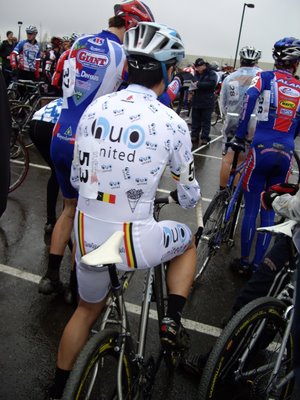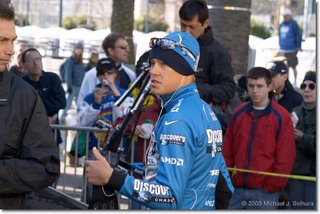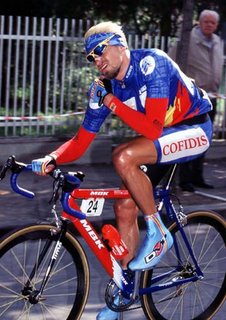For almost two years, I have been a loyal reader of
Zonebaby, which is the source for all that takes place in this little world we call our own. So, BKW was floored when Seth said he would write an article to help kick us off and provide a little street cred. Seth said he had an idea that would be a perfect fit for our little site. Call it a housewarming gift or a shamless promotion. We call it good fortune and we are honored to dedicate the bandwith to Seth. So, enjoy the read and be sure to drop by and pay Seth a visit. Tell him BKW sent you.
 (1994 was a strange and spectacular time for the Northern Classics. It was The Year of The Knicker. The spandex capri was everywhere! People who would normally never be caught dead with "3/4 tights" (Musseuw) donned them. Knickers: cycling's version of Zubaz - a "must have" for the chronically undecided, "Gee, do I wear shorts today, or tights, or legwarmers? I know, KNICKERS!
(1994 was a strange and spectacular time for the Northern Classics. It was The Year of The Knicker. The spandex capri was everywhere! People who would normally never be caught dead with "3/4 tights" (Musseuw) donned them. Knickers: cycling's version of Zubaz - a "must have" for the chronically undecided, "Gee, do I wear shorts today, or tights, or legwarmers? I know, KNICKERS!
I almost forgot that somebody decided to invite ALL of the Italians to the Tour of Flanders, and for one reason or the other, they all had mad form - someone (Dr. Ferrari, perhaps) had gotten the mix right.
I mean, it's odd to see four Italians literally ride away from the pack in a Belgian Classic, but that's exactly what happened - all from the same squadra (Gewiss), no less)The 1994 Tour of Flanders - the shit went down! I won't bore you with the details, but here are the players:
Johan CapiotCapiot's the Man (as far as I'm concerned). I know you want me to ramble on and on about another Johan "The Lion of Hair Plugs" Museeuw, but let's face it - Museeuw was the heavy, heavy favorite for 1994's Ronde, but couldn't seal the deal. Nope! He was beaten by a wistful and waning double World Champion, but more about that later.
So yeah, Johan Capiot epitomizes what I (and Bob Roll) refer to as "The Belgian Wide-Thigh". Go find a copy of this race on DVD (good luck) and study how Capiot sits on the bike: note the TVM cycling cap with just the right amount of "poof" for the Spring Classics (cycling cap poof varies with the time of year - peaking during the Grand Tours - the Giro in particular).
Note the copious application of leg embrocation (ie, Belgian kneewarmers)! Capiot's saddle height seems just a little on the low side - no doubt a concession to the several treacherous sections of
pave on the Flemish countryside.
Capiot, a Belgian sprinter, hard man and
rouleur a la mode serendipitiously starts the first real break of Der Ronde when Olaf Ludwig eats shit and creates a pile-up behind the unassuming Capiot. Johan, almost oblivious to the carnage in his wake, carries on the chore of pushing a biggish gear. He is the solo breakaway by default. Despite being in a break for almost the entire race, and not being the Boss of the Bosberg, he manages to hold on for fifth.
Johnny! Johnny Bug-nose! I always think of Bobby Digital when I think of Bugno, maybe because they're both crazy talented or just crazy crazy. Bugno: two time World Champion, leader of the Giro d'Italia from start to finsh (Bottechia, I believe, was the last human to pull that off), slayer of L'Alpe d'Huez, and all around nice guy. Bugno, riding for the Polti squad (sponsored by Coppi: the janky aluminum team bike of the early 1990s) was, at this time in his career, viewed as a mostly washed-up oddity. Despite his palmares, no one gave him much chance of sealing the deal at Der Ronde. Museeuw, Tchmil, Ballerini, and even Capiot had been viewed as having better chances. Booties? Yes. Kneewarmers? Not likely. Knickers? Never! Bugno unleashes a long, diesel sprint and schools Museeuw.
Il Campione does a pre-arrivee victory salute that nearly costs him the victory. We're not talking about Eric Zabel here - Bugno, in spite of himself, wins!
Big 'Dre TchmilOne Moldavian not to be messed with. He was, for all intents and purposes, a naturalized Belgian, given his penchant for sporting leather hair-nets and refusing to roll with anything vaguely resembling eye protection (or knee protection). Tchmil was suffering from ridiculously good form in the spring of '94. He would go on to win that year's Roubaix astride a Caloi (Okay, an Eddy Merckx) with Rock Shox and 8 speed STI levers - quite the high-tech set up 12 years ago. He finishes third, sans kneewarmers, behind Bugno and Museeuw.
Franco Ballerini Can't sprint. Can't win. Fourth.
Fabio Baldato One leg longer than the other + Goatee + Mullet dipped in product + Knickers = sixth place
Guido "Good Times" Bontempi The pre-Cipollini Cipollini. I think he rode tempo for the entire 1990 World Championship. Good Times elects to sport knickers and paid the price - seventh.
Johan "Zee hairclub por hommes" Museew I'm convinced, despite his palmares, that he's totally bald. Why be ashamed of that male pattern baldness, Johan? If you find a copy of the '89 Tour de France, you will see a bald Johan riding for Greg LeMond's feeble ADR squadra - look it up.
Anyway, Johan decided to wear knickers for this edition of Der Ronde. WTF, man? Are you not the Lion of Flanders? I know it's cold outside, but c'mon! His fashion
faux pas (knickers and a short sleeve jersey ??) ends us costing him the the victory - second.
Little Frank Corvers The plucky, defiant neo-pro - 10th. whatever happend to little Frank Corvers? Probably became a Lord of the Kermis.
Photo courtesy Het Nieuwsblad - Sportwereld 5/4/1994





















